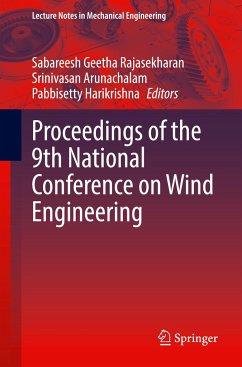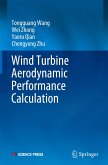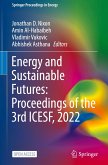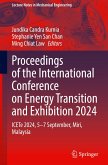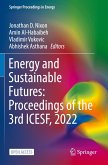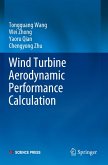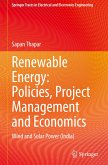Proceedings of the 9th National Conference on Wind Engineering
Herausgegeben:Rajasekharan, Sabareesh Geetha; Arunachalam, Srinivasan; Harikrishna, Pabbisetty
Proceedings of the 9th National Conference on Wind Engineering
Herausgegeben:Rajasekharan, Sabareesh Geetha; Arunachalam, Srinivasan; Harikrishna, Pabbisetty
- Broschiertes Buch
- Merkliste
- Auf die Merkliste
- Bewerten Bewerten
- Teilen
- Produkt teilen
- Produkterinnerung
- Produkterinnerung
The book presents the select proceedings of 9th National Conference on Wind Engineering. It covers the latest technology and research in the areas of wind engineering and wind energy technologies. Various topics covered in this book are wind-resistant design of structures, climate modeling, applications of artificial intelligence and machine learning in fluid mechanics, novel ways to increase the efficiency of wind energy harnessing, characterization of airfoils, modern wind turbine designs and computational wind engineering studies. This book is useful for researchers and professionals in the…mehr
Andere Kunden interessierten sich auch für
![Wind Turbine Aerodynamic Performance Calculation Wind Turbine Aerodynamic Performance Calculation]() Tongguang WangWind Turbine Aerodynamic Performance Calculation98,99 €
Tongguang WangWind Turbine Aerodynamic Performance Calculation98,99 €![Energy and Sustainable Futures: Proceedings of the 3rd ICESF, 2022 Energy and Sustainable Futures: Proceedings of the 3rd ICESF, 2022]() Energy and Sustainable Futures: Proceedings of the 3rd ICESF, 202238,99 €
Energy and Sustainable Futures: Proceedings of the 3rd ICESF, 202238,99 €![Proceedings of the International Conference on Energy Transition and Exhibition 2024 Proceedings of the International Conference on Energy Transition and Exhibition 2024]() Proceedings of the International Conference on Energy Transition and Exhibition 2024214,99 €
Proceedings of the International Conference on Energy Transition and Exhibition 2024214,99 €![Energy and Sustainable Futures: Proceedings of the 3rd ICESF, 2022 Energy and Sustainable Futures: Proceedings of the 3rd ICESF, 2022]() Energy and Sustainable Futures: Proceedings of the 3rd ICESF, 202231,99 €
Energy and Sustainable Futures: Proceedings of the 3rd ICESF, 202231,99 €![Wind Turbine Aerodynamic Performance Calculation Wind Turbine Aerodynamic Performance Calculation]() Tongguang WangWind Turbine Aerodynamic Performance Calculation76,99 €
Tongguang WangWind Turbine Aerodynamic Performance Calculation76,99 €![Renewable Energy: Policies, Project Management and Economics Renewable Energy: Policies, Project Management and Economics]() Sapan ThaparRenewable Energy: Policies, Project Management and Economics46,99 €
Sapan ThaparRenewable Energy: Policies, Project Management and Economics46,99 €![Renewable Energy: Policies, Project Management and Economics Renewable Energy: Policies, Project Management and Economics]() Sapan ThaparRenewable Energy: Policies, Project Management and Economics65,99 €
Sapan ThaparRenewable Energy: Policies, Project Management and Economics65,99 €-
-
-
The book presents the select proceedings of 9th National Conference on Wind Engineering. It covers the latest technology and research in the areas of wind engineering and wind energy technologies. Various topics covered in this book are wind-resistant design of structures, climate modeling, applications of artificial intelligence and machine learning in fluid mechanics, novel ways to increase the efficiency of wind energy harnessing, characterization of airfoils, modern wind turbine designs and computational wind engineering studies. This book is useful for researchers and professionals in the areas of structural design, wind energy, wind engineering, renewable energy and fluid mechanics.
Produktdetails
- Produktdetails
- Lecture Notes in Mechanical Engineering
- Verlag: Springer / Springer Nature Singapore / Springer, Berlin
- Artikelnr. des Verlages: 978-981-99-4182-7
- Seitenzahl: 176
- Erscheinungstermin: 23. August 2023
- Englisch
- Abmessung: 235mm x 155mm x 10mm
- Gewicht: 309g
- ISBN-13: 9789819941827
- ISBN-10: 9819941822
- Artikelnr.: 68131624
- Herstellerkennzeichnung
- Springer-Verlag GmbH
- Tiergartenstr. 17
- 69121 Heidelberg
- ProductSafety@springernature.com
- Lecture Notes in Mechanical Engineering
- Verlag: Springer / Springer Nature Singapore / Springer, Berlin
- Artikelnr. des Verlages: 978-981-99-4182-7
- Seitenzahl: 176
- Erscheinungstermin: 23. August 2023
- Englisch
- Abmessung: 235mm x 155mm x 10mm
- Gewicht: 309g
- ISBN-13: 9789819941827
- ISBN-10: 9819941822
- Artikelnr.: 68131624
- Herstellerkennzeichnung
- Springer-Verlag GmbH
- Tiergartenstr. 17
- 69121 Heidelberg
- ProductSafety@springernature.com
Prof. Sabareesh Geetha Rajasekharan is an associate professor at the Department of Mechanical Engineering, BITS-Pilani, Hyderabad Campus. He completed his Ph.D. and post-doctoral studies in the field of Wind Engineering at Tokyo Polytechnic University, Japan. He has to his credit more than 80 publications in international journals/conferences. He has ongoing/completed multiple projects to the tune of 2.2 crore funded by DST/DRDO/other agencies. Under him, 4 Ph.D. students have graduated and are presently guiding 3 students. His fields of interest are in Wind Engineering, Fluid Structure Interaction, Vibrations, Condition Monitoring, Machine Learning and Artificial Intelligence. He is also a recipient of Best Master's Thesis Award in the field of wind engineering constituted by Indian Society of Wind Engineering. Prof. S. Arunachalam, till recently, worked as the director, Wind Engineering Application Centre, Jaypee University of Engineering & Technology, Guna, in M.P., since2013. Earlier, he has worked as a chief scientist and the head, Wind Engineering Laboratory at CSIR-SERC, Chennai, for about 30 years. He obtained his B.E. (Civil) from Madras University and M.S. (Civil) and Ph.D. from IIT, Madras, and from IISc, Bangalore, respectively. His fields of research interest include wind effects on buildings and structures, boundary layer wind tunnel testing and cyclone disaster mitigation. He is a recipient of CSIR-DAAD and CSIR-UNDP Fellowships. He has published over 105 research papers in journals and conferences and about 200 technical and consultancy reports. He is a fellow of Indian National Academy of Engineering and Institution of Engineers (India). As a team member, he has contributed to Indian Standards on wind loads. Dr. P. Harikrishna is currently a chief scientist and the head of Wind Engineering Laboratory, CSIR-Structural Engineering Research Centre (CSIR-SERC), Chennai. He obtained his B.E. (Civil Engineering) from Andhra University,Waltair, M.E. (Structural Engg.) from Anna University, Chennai, and Ph.D. from Indian Institute of Technology-Madras, Chennai. His major areas of research interests include wind engineering, wind effects on tall buildings, lattice towers, cooling towers, chimneys and bridge decks, computational fluid dynamics (CFD), application of data mining/ML algorithms and small wind turbines. He has published 18 papers in SCI Journals and 11 papers in reputed national journals. Dr. Harikrishna received UNDP Fellowship in 1994, A.S. ARYA-UOR Disaster Prevention Award in 2000, Dr. Jai Krishna Medal in 2001, Dr. M. Ramaiah Award in 2004 and Springer Best Paper Award in 2016. Currently, he is a member of various BIS codal committees relevant to wind loads.
Chapter 1. Implementation of a simple CFD tornado simulator in open-source software open FOAM.- Chapter 2. Construction and calibration of a low-speed variable velocity profile wind tunnel.- Chapter 3. Aerodynamic characteristics of an inclined square cylinder with corner fins.- Chapter 4. Effect of unusual terrain on local wind characteristics.- Chapter 5. Vibrational characteristics of the LEP vertical axis wind turbine shaft for various solidity ratios.- Chapter 6. Performance analysis of n-beats and regression learners for wind speed forecasting and predictions.- Chapter 7. Effect of turbulence parameters on along-wind response of tall rectangular buildings.- Chapter 8. Wind pattern and dispersion in a T-intersection street canyon.- Chapter 9. Errors and uncertainties in simulation of unsteady viscous flow over a circular cylinder at Re=48.- Chapter 10. Aerodynamics analysis of industrial wind turbines.- Chapter 11. Computational technique adopted to study vortex formation inindustrial wind turbines.- Chapter 12. Shear lag effect in framed-tube buildings due to torsional wind load.- Chapter 13. Wind-induced interference effects on a 125 m tall RC chimney in typical power plant.- Chapter 14. Studies on 1:300 scale wind tunnel simulation of atmospheric boundary layer characteristics under open terrain conditions using a state-of-the-art boundary layer wind tunnel.- Chapter 15. Tornado Speed Estimation using Convolutional Neural Networks (CNN) and LSTM (Long Short-Term Memory) based Video processing Approach.
Chapter 1. Implementation of a simple CFD tornado simulator in open-source software open FOAM.- Chapter 2. Construction and calibration of a low-speed variable velocity profile wind tunnel.- Chapter 3. Aerodynamic characteristics of an inclined square cylinder with corner fins.- Chapter 4. Effect of unusual terrain on local wind characteristics.- Chapter 5. Vibrational characteristics of the LEP vertical axis wind turbine shaft for various solidity ratios.- Chapter 6. Performance analysis of n-beats and regression learners for wind speed forecasting and predictions.- Chapter 7. Effect of turbulence parameters on along-wind response of tall rectangular buildings.- Chapter 8. Wind pattern and dispersion in a T-intersection street canyon.- Chapter 9. Errors and uncertainties in simulation of unsteady viscous flow over a circular cylinder at Re=48.- Chapter 10. Aerodynamics analysis of industrial wind turbines.- Chapter 11. Computational technique adopted to study vortex formation inindustrial wind turbines.- Chapter 12. Shear lag effect in framed-tube buildings due to torsional wind load.- Chapter 13. Wind-induced interference effects on a 125 m tall RC chimney in typical power plant.- Chapter 14. Studies on 1:300 scale wind tunnel simulation of atmospheric boundary layer characteristics under open terrain conditions using a state-of-the-art boundary layer wind tunnel.- Chapter 15. Tornado Speed Estimation using Convolutional Neural Networks (CNN) and LSTM (Long Short-Term Memory) based Video processing Approach.

